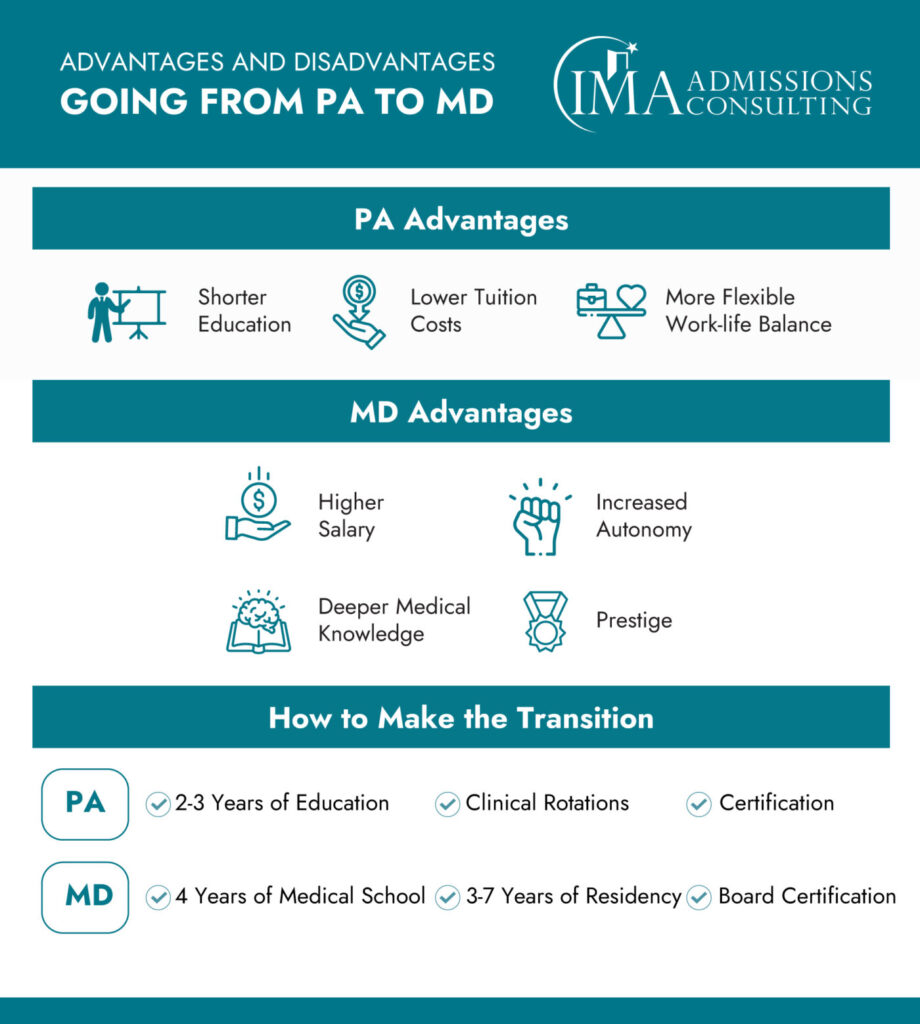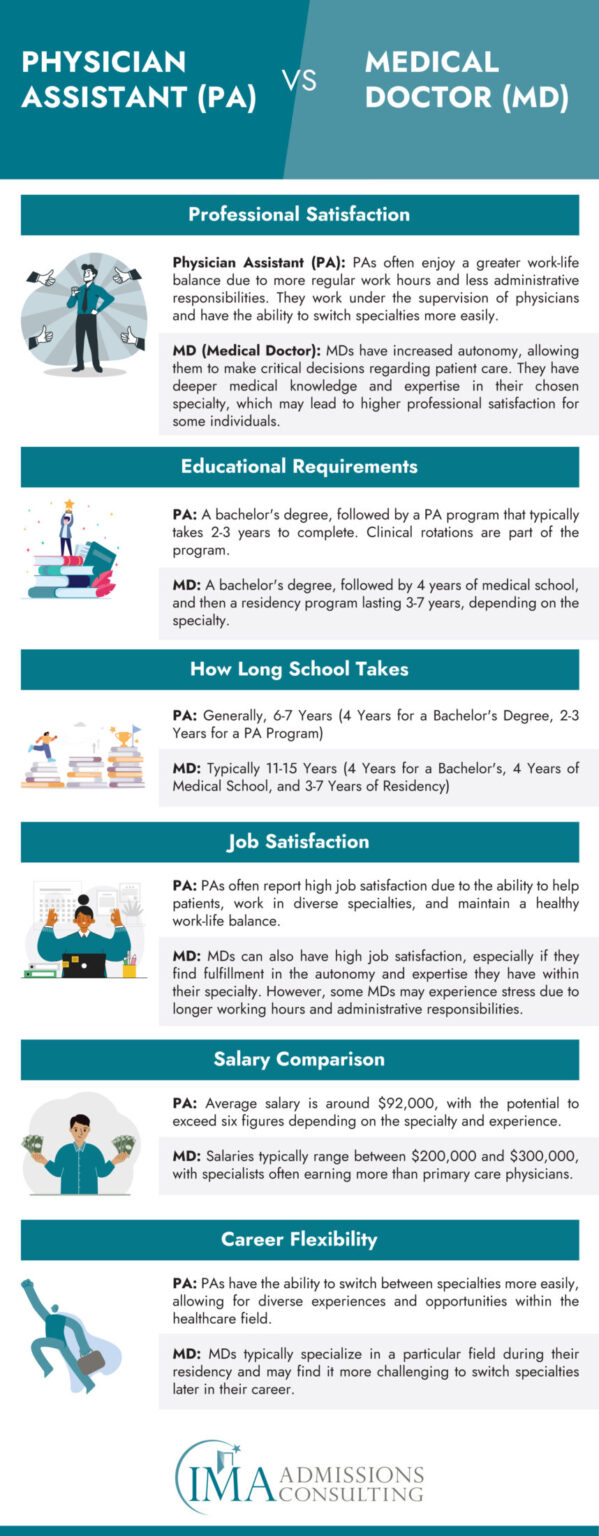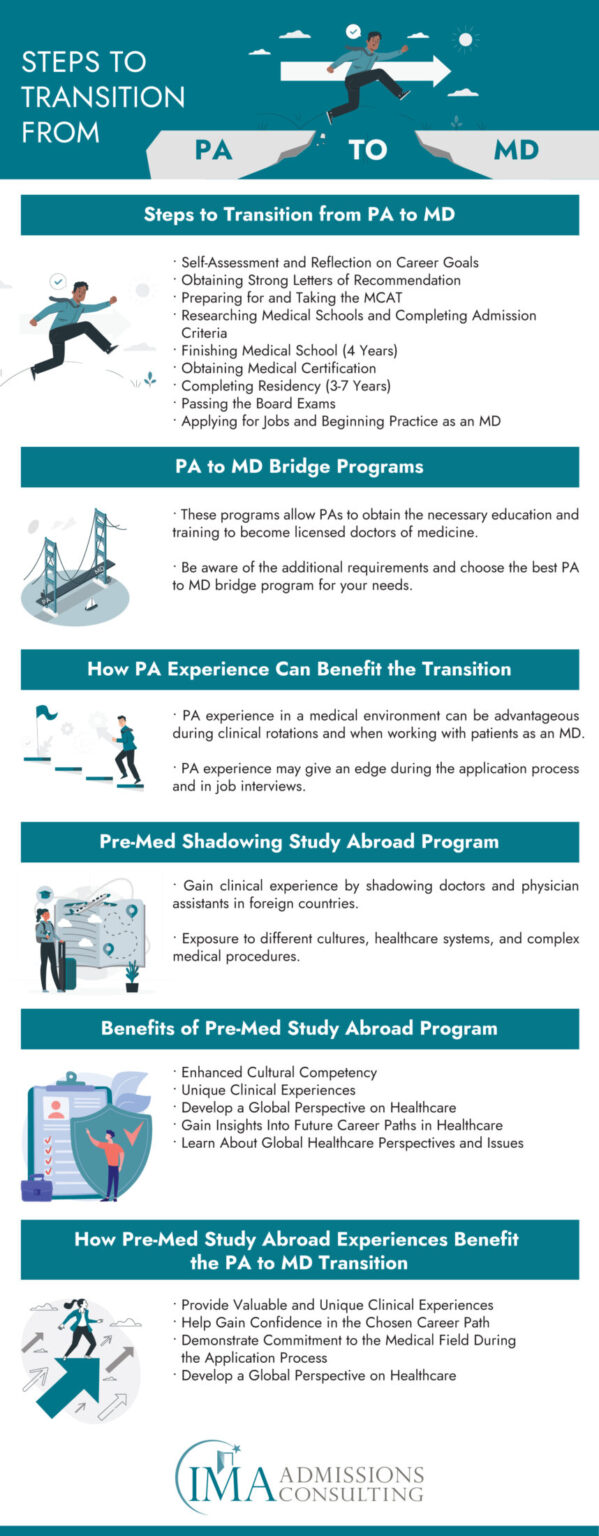Introduction
Working with patients as a physician assistant can be tremendously fulfilling. However, as your career as a physician assistant (PA) develops, you may be prepared for different duties. You can try to further your education and obtain an MD to pursue a career as a doctor of medicine. By being aware of the additional requirements, you can be part of the best PA to MD bridge programs.
In this article, we go through the benefits of changing careers from PA to MD as well as concrete measures you can take in PA to MD programs.
History and Scope
The physician assistant position was initially conceptualized in the United States in the middle of the 20th century. The first academic curriculum for educating physician assistants was established in 1965, with a graduating class of 1967, and was inspired by the rapid training for doctors during World War II.
Since then, physician assistant careers have progressively increased in popularity and competition throughout the United States. Currently, the Physician Assistant Education Association (PAEA) in the United States has certified more than 250 programs.
The profession is expanding rapidly, with more healthcare systems and medical practitioners seeking to recruit physician assistants to diversify the availability of healthcare and cut expenses involved with only employing physicians. As a result, the job prospects for qualified physician assistants are currently quite appealing.
With many nations developing and embracing academic programs to start, including physician assistants in the health sector, the function has also begun to acquire traction in global healthcare systems. For instance, Canada graduated its first academic PA class in 1984 from the Canadian Forces Medical Services School.
Since then, three further curriculums have been created at McMaster University, the University of Toronto, and the University of Manitoba. To address the high costs and long wait times in Canadian healthcare, there is, in fact, an increasing interest in extending physician assistant employment. As a result, it can be a highly lucrative and rewarding job for those who want to work in healthcare.
What is a PA?
A PA is a certified medical professional who interacts with patients under the direction of a doctor. Physician assistants can evaluate patients, dispense medication, and request tests.
They can recommend lifestyle changes to patients, stitch wounds, set bones, administer vaccinations, and manage patient records, much like doctors.
In some ways, a physician assistant is an extension of the supervising doctor, a resident that stays in the office and helps the doctor simplify patient care while concentrating on the trickier cases and treatments.
In light of this, becoming a physician assistant can open the door to a fulfilling career that prioritizes patient care while removing some of the more challenging aspects of working in medicine, such as assuming accountability and obligations for treatments and managing the administrative facets of a medical profession.
However, physician assistants play a crucial part in the healthcare sector since they reduce some pressure on doctors by taking on jobs that they can monitor without having to be there in person.
As a result, they can aid in enhancing healthcare accessibility and decreasing patient wait times. Also, even though most physician assistants work in ambulatory clinical settings, such as general care, many also do so in hospitals and other specializations, giving people intrigued by the field a wide range of potential practice areas.
What is a Doctor?
A doctor is a certified medical practitioner with a Doctor of Medicine degree. Doctors examine patients, make medical diagnoses, and prescribe medications. They can treat patients autonomously. When necessary, they might also carry out specific surgical treatments. Many medical professionals have specialties in particular fields and can fully treat and diagnose patients.

PA VS MD: What’s the Difference
Physician assistants and doctors undertake almost similar tasks and responsibilities. Both of them go to school for several years before working with patients one-on-one, diagnosing illnesses and providing treatments. But they are not nearly the same.
Knowing the distinctions between a doctor and a physician assistant will help you make the best career decision if you’re considering a career in the healthcare industry. Let’s look at what makes them unique and how to decide which to pursue.
Educational Requirements for PA vs MD
Long before either profession starts practicing, a PA and a doctor differ from one another. Both medical doctors and physician assistants are required to take science-related courses. They both study the same subjects, although an MD might need more rigorous coursework and programs. With MDs, the fees, grade standards, and duration could also be more demanding.
The criteria are strict and the coursework is more difficult. Physicians need to undergo 3–7 years of residency training in addition to obtaining and maintaining national and state board certification.
Although PA criteria are less demanding, they nevertheless shouldn’t be ignored. The educational requirements for PAs typically last six years, with small variations across states and particular institutions. Before working as a full-fledged PA, PAs must undergo one year of practical medical training (comparable to doctor’s residency) and ongoing education requirements to keep their credentials.
PA schools frequently demand top grades and considerable clinical experience. The accepted average GPA is 3.5, and the required science GPA is 3.47. PAs also have a testing standard that can change depending on the medical schools.
While some PA programs examine MCAT scores, others require candidates to have an average GRE score of 310. PAs must have 2,000 hours of in-patient care experience, which is a significant amount of clinical expertise. They can work as volunteers in hospitals, clinics, or other healthcare facilities.
On the contrary, MDs have lower clinical experience at the application stage but greater grade expectations. Students must have an overall GPA of 3.70 and a science GPA of 3.64.
Medical schools do not require GRE scores, but they demand an average MCAT score of at least 508. You can enroll in these programs without any prior clinical experience, although doing so can help you stand out from other applicants.
In general, students must finish at least nine years of schooling and medical training in order to become doctors. You must have an MCAT score of 508 or higher and a minimum GPA of 3.64 to be admitted to qualify for PA to MD bridge programs in Texas.
PA vs MD Job Functions
There’s a lot of convergence in job functions between a doctor vs PA. In terms of identifying and treating illnesses and diseases, they both provide direct patient care. They both look over the patient’s medical history to advise treatments and recommend medications. Each one also conducts and implements clinical guidelines and provides patient counseling.
One of the most significant distinctions is that doctors can work independently, whereas a doctor directly supervises PAs. Moreover, PAs can support doctors during procedures but not carry them out independently. Here is the scope of their roles:
Under the direction of a doctor, physician assistants primarily serve as diagnosticians on the healthcare team. They can conduct physical exams, gather medical histories, lab results, imaging data, and other data to diagnose diseases and develop a treatment strategy.
PAs are permitted to do office duties but not surgical procedures. Also, they have the ability to administer drugs, although not controlled narcotics or prescriptions that need a doctor’s prescription.
On the other hand, medical doctors can do the tasks that PAs can without any delegation or oversight from a person of higher rank. They are able to diagnose medical disorders independently, recommend medications, perform procedures, and treat patients.
PA vs MD Flexibility and Control
An MD supervises every PA at work. Although PAs sometimes operate solo, they must cooperate with doctors in complex medical situations.
Even though PAs aren’t allowed to start their own medical enterprises, MDs frequently own clinics and offices. Nonetheless, they have numerous obligations and responsibilities.
Because they frequently manage more complicated diseases, uncommon medical cases, and procedures, MDs must also be available on call. Therefore, they can arrange schedules but must be prepared to work unexpected shifts in case of emergencies.
PA vs MD Education Cost
Education cost for doctors is higher since it requires a number of additional years of school to qualify to be a doctor. The average cost of education is about $278,000 for private medical schools and about $207,000 for public schools.
Although expensive, PA school is still considerably less expensive than attending medical school. A 27-month PA program typically costs $71,000 for residents and around $90,000 for non-residents in the US.
PA vs MD Job Satisfaction and Lifestyle
Most PAs put in 40 hours each week. They keep more regular schedules, increasing stability and job satisfaction rates.
Unfortunately, doctors have less control over their schedules because they have to oversee and run clinics as well as work every day in hospitals. Due to their busy medical schedules, MDs put in more than 60 hours a week.
Salary
A doctor’s earning potential can easily offset the hefty cost of study. Doctors generally make between $200,000 and $300,000 annually (in other words, a single year of employment can pay off med school debt).
The real income will change depending on the speciality, practice area, bonuses, and profit sharing. Specialists typically have higher salaries than PCPs, who typically have lower salaries.
Comparatively, the PA wage is substantially lower, yet it’s still nothing to be concerned about. The average PA income is around $92,000. However, it can easily exceed six figures.
In the following ten years, it is anticipated that there will be significant job growth for both doctors and PAs.

Benefits of Transitioning from a PA to MD
Being aware of the advantages of enrolling in a physician assistant to MD program can assist you in deciding whether it is the best career move. Here are some of the benefits of transitioning from a PA to MD:
Autonomy
Despite the fact that doctors and PAs have many duties in common, doctors often have more freedom in their work. A PA works under the direction of a doctor to carry out job responsibilities like patient examinations and treatment plan creation. Physicians undertake more complex responsibilities, such as performing operations, and operate more independently than PAs.
Specialization
The most common medical specialties for doctors are internal medicine, family practice and pediatrics. They emerge proficient in their field and can identify and manage complex medical conditions. On the other hand, PAs frequently work in primary care and may seek assistance from experts on particular medical conditions.
Salaries
Generally, doctors can earn more attractive incomes than PAs. PAs make an average of $105,470 a year compared to doctors, who make an average of $196,501. Doctors can frequently earn more money by specializing in a particular branch of medicine.
Medical professionals’ average salary can vary depending on their area, employment, and level of expertise.
Disadvantages of Transitioning from a PA to MD
On the other hand, the independence of the MD profession in comparison to the PA can sometimes be considered a drawback. Since many self-employed physicians’ medical practices are fundamentally their companies, this structure can frequently result in an excessive amount of responsibility related to the upkeep and management of the business in lieu of the actual practice of medicine.
While physician assistants can frequently have a typical 9–5 weekday with a pleasant work/life harmony, a physician is much more inclined to put in long hours and can develop burnout while managing every part of their medical business,
Similarly, the independence of giving medical care singly might also result in a difficult situation. Since physician assistants always act in the doctor’s place, they are only accountable to the doctor who supervises them. In comparison, the doctor always assumes ownership of the treatment, regardless of whether they provide it directly or delegate it to others.
As a result, the doctor is always responsible for the care and any issues that may arise as a result of it. A physician’s employment includes a significantly higher degree of accountability and stress than a PA’s, along with the duties related to managing the many facets of the practice.
By switching from being a PA to MD, you can also lose some of the freedom related to the field of medicine you can work in. Since physician assistants often receive on-the-job training for the specific medical specialties in which they specialize, they frequently wind up practicing in several areas of medicine during the course of their careers.
In contrast, medical doctors select their specialty at the residency phase of their study. As a result, they are unable to switch subspecialties without beginning over and finishing residency and possibly even fellowships in the new field.
The major drawback of enrolling physician assistants in medical doctor programs is the time, money, and effort required to make a move. A career as a PA doesn’t offer shortcuts on the path to becoming a fully licensed MD.
This implies that if you are dedicated to switching from a PA to MD, it will take a while to prepare your approval process, you will have to quit working full-time to attend school, you will have to pay a high tuition rate for medical school, and it will take a while to complete a residency (and possibly a fellowship if you choose to pursue a subspecialty) prior to being licensed to practice autonomously.
Given these factors, you must carefully assess your dedication and interests before transitioning from a PA to MD.

Can PAs Become Doctors?
So, can a Physician assistant become a doctor? Yes, PA to MD shift is feasible. Here are the steps you can take to change from a PA to MD:
Reflect Your Career Path
To join physician assistant to medical doctor programs, be certain that you want to become a doctor before submitting an application to medical school. If you wish to have more independence and responsibility, you might be ready for this exciting job shift.
Like becoming a PA, being a doctor also takes time, effort, and commitment. Think about whether you want to practice general medicine or concentrate on a particular branch of medicine.
Recommendation Letters and MCAT
Your initial steps of transitioning from PA to MD will probably start around two years before the year in which you expect to gain admission, just like they do for the majority of other potential students applying to medical school.
You must begin planning at this point for who you will ask for letters of recommendation for medical school. Most medical school applications need at least a few letters of recommendation from professors, which might be tricky if you graduated from college years ago and are now working as a physician assistant.
When you begin to get ready for the MCAT, it will be critical to take a second look at your individual requirements for medical school. Since PA schools typically do not require the MCAT, your preparation for a physician assistant to medical doctor programs will be heavily centered on succeeding on this exam.
It is very likely that you will have completed the science courses that are required for the MCAT all through your undergraduate program. However, the sheer amount of years that have passed between receiving your bachelor’s degree before embarking on a career as a physician assistant and your ongoing practices to apply to medical school will presumably present a challenge for you.
The three knowledge-based sections of the MCAT, notably the MCAT biology, chemistry, and psychology, include a variety of topics, therefore it will be crucial for you to set up time to review them. Despite the fact that some of your skills and knowledge from working as a physician assistant will be useful in these areas, you will probably need to refer back to your textbooks to refresh your memory.
Similar to that, you must start getting ready for the difficult fourth MCAT section, the Critical Analysis and Reasoning Skills (CARS). This section focuses on your reading comprehension and analysis skills even if it does not assess your prior knowledge.
As a result, it is a very difficult section of the MCAT and necessitates a strong MCAT CARS approach that includes continual active reading, exposure to difficult literature, and vocabulary practice. One of the greatest methods to get ready for the MCAT CARS is to practice with the examples offered by the AAMC because the passages and questions on the exam are fairly dissimilar from the texts we come across on a daily basis.
The MCAT should ideally be completed with enough time remaining in your schedule to allow for a retest if necessary. Waiting until you are prepared to complete the test well is crucial, though. It is preferable to wait until you can take a practice MCAT and get a score in the 90th percentile before deciding this. Though few and far between, there are several medical schools that do not require the MCAT.
Research Medical Schools
As you transition from PA to MD, look for medical colleges that fit your criteria. For instance, several medical schools offer accelerated PA to MD programs that allow you to complete your education in three as opposed to four years.
Although PA to MD programs can be more demanding, this is a wonderful option for people who want to complete less education and move from PA to MD as quickly as possible. Since applying to medical school is expensive and time-consuming, it is vital to only concentrate on institutions that you’re strongly contemplating enrolling and that you can have moderate to high success with.
Along with contrasting your GPA and MCAT score (if available) to the figures of the enrolling class, you can also evaluate your past experiences to the profile of prospective candidates.
Here, your prior experience working as a physician assistant in a medical environment will be a significant addition to your background.
You should keep in mind that, in addition to your career history in healthcare, numerous medical schools also place significant emphasis on community service and volunteer experience. It is therefore crucial to establish these components of your medical school application.
Before considering a physician assistant to medical doctor programs, it is vital to evaluate your potential student loan debt after medical school to set a budget for your study. Consider your current student debt as well as the lifestyle you wish to lead while in school when creating your budget. This may aid in your decision of the medical school you should attend.
Complete Admission Criteria
You might need to finish a certain number of requirements before being accepted to transition from PA to MD. They normally vary by institution, and on occasion, the admissions requirements may be satisfied by your prior training as a PA or your prior schooling.
To be sure you have the necessary credentials, carefully review the various entry requirements for the institutions you are interested in attending.
The Medical College Admissions Exam is another requirement for most medical schools (MCAT). Although the knowledge you gained while working as a PA can be useful for this exam, it’s crucial to prepare effectively to receive the best score.
Medical schools may also need you to submit a personal statement and get letters of recommendation in addition to the MCAT.
Finishing Medical School
A big number of medical school PA to MD programs last for four years. They are divided into two sections: pre-clerkship instruction and clinical rotations. In the course of instructions, you receive education in the form of lectures and labs in the classroom.
After completing your first two years of medical school, you will work in a real medical environment and gain experience by helping patients. When you work with patients frequently as a PA, you may have an advantage during rotations.
Get a Medical Certification
The qualifications for changing from PA to MD are somewhat similar to those for PA licensing. By passing the United States Medical Licensing Examination, you can obtain this license (USMLE). There are three sections to the test.
Usually, the first two parts are finished while you are in medical school, and the last part is finished once you have graduated. Depending on where you are, you can take the exam a different number of times.
You can apply to become an MD with your state’s licensing board after passing the USMLE. Normally, your application contains evidence that you completed a recognized medical education program and passed the USMLE.
To be part of physician assistant to medical doctor programs, a background check may be required in some places as an additional requirement. According to current regulations, the majority of states require that you renew your license annually.
Finish Your Residency
Postgraduate residency training is typically completed by aspiring doctors in three to seven years. As you complete your residency, you gain experience as a doctor and put all of your skills to use.
Pass the Board Test
Earning at least one certification from the American Board of Medical Specialties allows almost all doctors to become board certified.
By passing the test specific to your field of practice, such as surgery or internal medicine, you can obtain this certification. As long as you meet the requirements, you can obtain board certification in as many different fields as you like.
Job Applications
As you near the end of your residency or fellowship, start searching for jobs. Make a medical resume or CV that highlights your education, accomplishments, and publications. Adding your experience as a PA can give you an edge from other applicants as it exhibits additional experience.
Start Practicing as an MD
Once you’ve completed the state’s license requirements, you’ll have converted from physician assistant to doctor in legal terms. Please keep in mind that you have to adhere to the continuing medical education standards in these PA to MD programs.
You will have the opportunity to work with patients who depend on your medical knowledge no matter what kind of medical practice you select.

How Long are PA to MD Programs?
Unlike doctors, physician assistants are not expected to have extra certifications or undergo extensive training to switch specialties, which interests many students choosing between the two occupations. After earning an undergraduate degree, becoming a PA can take an additional 3–4 years, while becoming an MD can take an additional 8 years. While a PA degree is less expensive, a practicing PA’s pay is also considerably lower than that of an MD.
Pre-Med Shadowing Study Abroad Program
Studying abroad is a common element of the college experience for many people. Unfortunately, many pre-med students have fewer options that meet their needs due to the intensity and particular challenges of the pre-med programs.
Although it is not necessary to study abroad in order to enter medical school, having the chance to learn about medicine in another nation and work as a physician assistant overseas can help pre-med students become better doctors.
Pre-Med Study Abroad: What is It?
Pre-med students also have the chance to shadow doctors and gain clinical expertise to a larger depth, breadth, and amount of hours as compared to experiences in the US, in addition to the normal study abroad experiences like traveling. Pre-medical study abroad trips might span a few weeks during college breaks and take place in a nation with a unique health care delivery system.
Benefits of Pre-Med Study Abroad
Although pre-med students are not permitted to practice medicine while studying abroad, they are nonetheless gaining invaluable clinical experience. Here are a few more advantages of studying abroad for pre-medicine:
- Experience Various Cultures: A pre-medical study abroad PA to MD programs allows students to get fully immersed in both the local culture and the healthcare industry. With other programs, it can be challenging to maintain this equilibrium.
- Shadow Complex Procedures: Complex operations cannot usually be shadowed by students in the United States. Pre-Med Shadowing Study Abroad Program permits students to observe operations and other advanced work they may not otherwise be able to see.
- Decide Your Future in Healthcare: Pre-medical study abroad PA to MD programs frequently assist students in identifying their areas of passion. There are limits to what you can learn in a classroom, so observing in a foreign country might help you decide whether you’re psychologically and physically capable of pursuing a career in the medical field. More importantly, this experience can assist you in sharpening your career focus and gaining confidence in your selected course of action.
- Learn About Global Healthcare: Pre-medical study abroad exposes students to aspects of global healthcare that are not possible to learn about in a traditional classroom setting. You will confront many problems in your future profession, and success depends on having a global perspective on healthcare (i.e., understanding what is effective in other nations and what is not). Speaking intelligently on the state of universal healthcare is also helpful while applying to medical schools.
Final Thoughts
It’s crucial to consider the big picture while deciding between a career as a PA and one as a doctor. Along with your job responsibilities, you should consider how long it will take you to qualify for the practice, how much it will cost, and how much money you can anticipate to make in total after completing a PA to MD programs.
No matter your stats, whether you are conventional or non-traditional, a first-time or repeat candidate, whether you have exceptional or average experience, and most importantly, no matter your age, gender, or cultural background, we will assist you at every step of your medical school admissions consulting process to present your best self.
FAQ:
What is a physician assistant (PA)?
A PA is a qualified healthcare expert who, under a physician’s guidance, can assess patients, prescribe medications, suture injuries, set fractures, provide immunizations, and maintain patient records. Acting as an extension of the overseeing physician, PAs have a variety of potential practice domains.
What is a doctor?
A doctor is an accredited medical practitioner with a doctor of medicine degree. Doctors evaluate patients, establish medical diagnoses, and perform specific surgical procedures. They undergo at least three years of residency training and continuous education prerequisites to maintain their qualifications.
What are the differences between a PA and an MD?
Although PAs and MDs have similar responsibilities, doctors can work independently, while doctors directly supervise PAs. Moreover, PAs can support doctors during procedures but not carry them out independently. MDs have more rigorous educational requirements, need more clinical experience, and can diagnose medical disorders independently, prescribe medications, perform procedures, and treat patients.
What are the educational requirements for becoming a PA or an MD?
PA programs often require high grades and substantial clinical exposure, with a minimum of nine years of education, medical preparation and a minimum GPA of 3.50.
MDs require at least nine years of schooling and medical training, with a minimum GPA of 3.70 and an MCAT score of 508 or higher.
What is the job satisfaction and lifestyle of a PA or an MD?
Most PAs work 40 hours per week, with more regular schedules, increasing stability, and job satisfaction rates. MDs work in hospitals and oversee clinics, leading to less control over their schedules and often working over 60 hours per week.
What is the salary difference between a PA and an MD?
Doctors generally earn between $200,000 and $300,000 per year, while specialists typically have higher incomes. The average PA salary is around $92,000, although earnings can easily surpass six figures in certain specialties. Substantial job growth is expected for both doctors and PAs in the coming years.
What are the benefits of transitioning from a PA to MD?
Advantages of moving from a PA to MD include increased responsibility and the ability to specialize in a specific medical field. PA to MD conversion programs offer an opportunity for PAs to transition to a new level of medical practice. Since PA programs typically do not cover all the necessary content, PA to MD conversion programs focus on critical analysis and reasoning abilities to help students move from PA to MD.
What are the disadvantages of transitioning from a PA to MD?
Drawbacks of evolving from a PA to MD involve an immense amount of responsibility associated with maintaining and managing the practice and addressing any problems that may emerge due to their chosen specialty during the residency stage of their education.
What are the benefits of enrolling in a physician assistant to MD program?
Participation in a pre-med observation study abroad program can provide an international outlook on healthcare and offer valuable experience for those considering PA to MD conversion programs. These programs are designed to help PAs advance their careers and contribute more significantly to the healthcare field.
While transitioning from a PA to MD can be challenging, the rewards can be significant for those who are dedicated and passionate about their medical career. By taking advantage of the resources and opportunities available, physician assistants can successfully navigate the path to becoming medical doctors and make a lasting impact on the healthcare field.
How does the job market look for PAs and MDs?
In the next ten years, there is expected to be significant job growth for both doctors and PAs. The profession of a physician assistant is expanding rapidly, with more healthcare systems and medical practitioners seeking to recruit physician assistants to diversify the availability of healthcare and cut expenses involved with only employing physicians. Similarly, the need for medical professionals, including doctors, will increase as the population ages and requires more medical care.
Are there any bridge programs from PA to MD?
Yes, bridge programs are available for PAs who wish to become MDs. These bridge programs allow PAs to obtain the necessary education and training to become licensed medical doctors. By being aware of the additional requirements, you can be part of the best PA to MD bridge programs.
How do I decide if transitioning from a PA to MD is the right career move for me?
To decide whether transitioning from a PA to MD is the right career move for you, you should consider factors such as your interest in medicine, willingness to commit to additional schooling, desire for autonomy and specialization, potential salary, and job satisfaction. You may also wish to speak with other medical professionals and explore the various educational programs and career paths available.
Can physician assistants become doctors?
Yes, it is possible for a physician assistant (PA) to become a doctor (MD), but it requires a large amount of time, effort, and commitment.
What are some differences in the roles of PAs and doctors?
Physician assistants often work under the supervision of a doctor, while doctors assume ownership of the treatment and are responsible for any issues that may arise. PAs may also have more flexibility in their field of medicine, while doctors choose their specialty at the residency phase of their study.
What are the steps to transition from a PA to an MD?
To transition from a PA to an MD, individuals must reflect on their career path and ensure they are ready for the significant commitment required. They must also prepare for the Medical College Admission Test (MCAT) and research medical schools that fit their criteria. After completing the necessary admission criteria, individuals must complete medical school, obtain a medical certification, finish their residency, and pass the board test.
How can PAs prepare for the MCAT?
Since PA schools typically do not require the MCAT, PAs must prepare for the exam by reviewing the required science courses and studying the MCAT biology, chemistry, psychology, and Critical Analysis and Reasoning Skills (CARS) sections. Practice exams and examples provided by the Association of American Medical Colleges (AAMC) can also be helpful.
What are some of the requirements for admission to physician assistant to medical doctor programs?
Admission requirements for a physician assistant to medical doctor programs vary by institution, but individuals may need to complete certain prerequisites, such as the MCAT, personal statement, and letters of recommendation. Additionally, a background check may be required in some places as an additional requirement.
What are the drawbacks and benefits of an accelerated PA to MD program?
An accelerated PA to MD program may allow individuals to complete their education in three years instead of four, but it can also be more demanding. It is important to carefully evaluate the benefits and drawbacks of such a program before applying.
What is the United States Medical Licensing Examination (USMLE)?
The United States Medical Licensing Examination (USMLE) is an essential part of the process, and the initial two segments are required for PA to MD conversion programs. A background investigation may be necessary for some locations as an extra prerequisite. Obtaining at least one certification from the American Board of Medical Specialties is also important, depending on the chosen area of practice, such as surgery or internal medicine.
What is required to become board certified as a doctor?
Almost all doctors become board certified by earning at least one certification from the American Board of Medical Specialties. To obtain certification, individuals must pass the test specific to their field of practice, such as surgery or internal medicine, and meet the other requirements set by the board.
Can a Physician Assistant (PA) become a Medical Doctor (MD)?
Yes, a PA can transition to becoming an MD. This process involves several steps, including reflecting on your career path, obtaining recommendation letters, preparing for and taking the MCAT, researching medical schools, completing admission criteria, finishing medical school, obtaining medical certification, completing residency, passing the board test, applying for jobs, and starting to practice as an MD.
How long does it take to transition from PA to MD?
The transition from PA to MD can take several years. It involves completing medical school, which typically lasts four years, and then completing a residency that can last between three to seven years, depending on the chosen specialty. Additional time may be required for fellowships and board certifications.
How does a PA's experience influence their transition to an MD?
A PA’s experience can be beneficial during the transition to MD, as it may give them an edge during the application process and in job interviews. Their experience in a medical environment can be an advantage during clinical rotations and when working with patients as an MD.
What is IMA’s Pre-Med Shadowing Study Abroad Program?
The Pre-Med Shadowing Study Abroad Program allows pre-med students to gain clinical experience by shadowing doctors and working as physician assistants in foreign countries. These programs expose students to different cultures, healthcare systems, and complex medical procedures that they may not experience in their home country.
What are the positive results of participating in a IMA’s Pre-Med Study Abroad Program?
Some benefits of participating in a Pre-Med Study Abroad Program include:
- Experiencing different cultures and healthcare systems
- Shadowing complex medical procedures that may not be possible in the home country
- Gaining insights into future career paths in healthcare
- Learning about global healthcare perspectives and issues
How can pre-med study abroad experiences benefit the PA to MD transition?
Pre-med study abroad experiences can help develop a global perspective on healthcare, enhance cultural competency, and provide unique clinical experiences that may be valuable during the transition from PA to MD. These experiences can also help students gain confidence in their chosen career path and demonstrate their commitment to the medical field during the application process.






